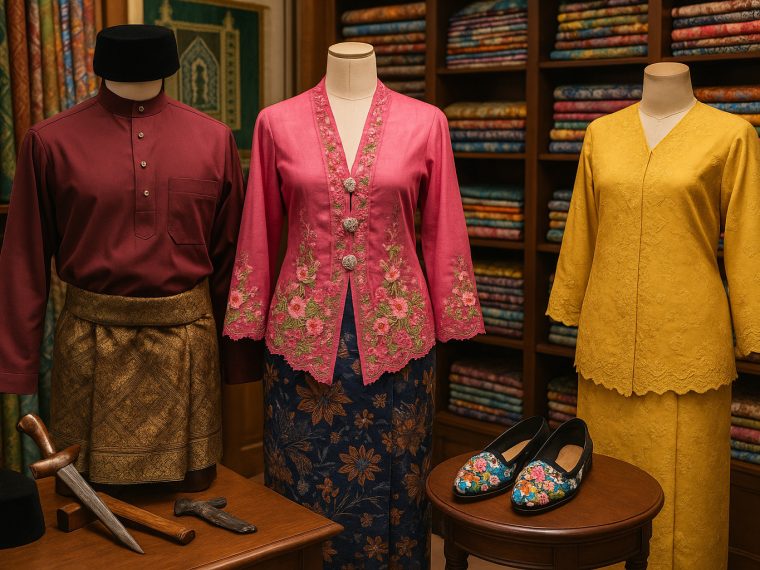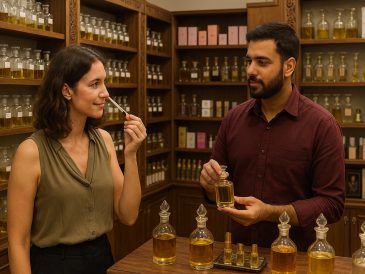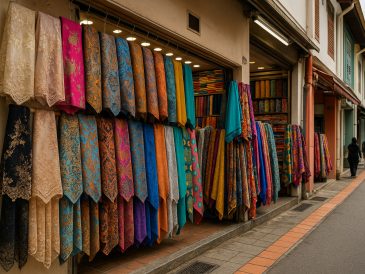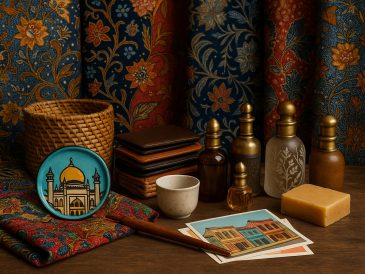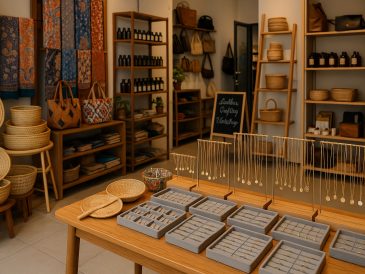Traditional Malay attire and accessories represent generations of artistry, customs, and symbolism. If you’re in Singapore, few places offer a deeper, more textured encounter with Malay heritage than Kampong Glam. This guide maps out the key streets and shops where cultural authenticity thrives, and where textiles and garments still tell stories.
Arab Street: The Textile Powerhouse
Arab Street is where the traditional Malay wardrobe begins. With its dense lineup of fabric shops and generations-old establishments, this street is where form meets fabric.
What You’ll Find
- Cotton batik for everyday Baju Kurung
- Handwoven songket with gold and silver threads
- Chiffon, silk, and embellished georgette for ceremonial garments
- Ready-made kebayas and batik shirts
Shops to Visit
- Toko Aljunied: Known for batik, songket, and Nyonya kebayas. Offers both fabric and ready-made garments.
- Bobby’s Fabrics: Ideal for weddings and special occasions, with premium silk and detailed embroidery.
Beyond fabric, expect prayer mats, songkok headwear, and tudung options for women. Many shopkeepers have deep textile knowledge, making your visit both practical and educational.
Haji Lane: Modern with a Cultural Twist
Haji Lane, known for its boutique flair and vibrant murals, introduces a creative intersection of tradition and trend. This is the street for modern spins on heritage pieces.
What You’ll Find
- Contemporary kebayas with unconventional cuts
- Batik prints integrated into dresses, shirts, and skirts
- Ethnic motifs on jewelry, clutches, and scarves
- Handcrafted accessories from independent artisans
Each boutique brings its interpretation of Malay culture, ideal for those looking to honour traditions with a modern silhouette.
Bussorah Street: Tradition in Every Stitch
With the Sultan Mosque as its backdrop, Bussorah Street has a slower pace and deeper cultural undertones. It’s a place to see attire in context—among shophouses, calligraphy displays, and Islamic art.
What You’ll Find
- Ready-to-wear Baju Kurung and Baju Melayu
- Accessories such as kerongsang (traditional brooches)
- Handicrafts and ceremonial garments
- Traditional footwear and songket sarongs
Shops to Visit
- Kebaya by Ratianah: Offers well-constructed kebaya and Baju Kurung with faithful detailing.
- Various souvenir shops: Stock practical and ceremonial Malay attire, alongside accessories.
Malay Heritage Centre Gift Shop
Located on the grounds of the former Sultan’s palace, this curated shop emphasizes authenticity and artisan craftsmanship. Prices are fixed, but the quality aligns with museum standards.
What You’ll Find
- Songket woven by regional artisans
- Books on Malay history and culture
- Traditional games and cultural keepsakes
- Miniature instruments like kompang and gambus
This isn’t a place for tailoring or casual browsing, but it offers cultural depth through each item.
Key Garments and Where to Source Them
Baju Kurung
- Style: Modest long blouse over a full-length skirt
- Where: Arab Street for fabric; Bussorah Street and Toko Aljunied for ready-made versions
Baju Melayu
- Style: Long-sleeved shirt with trousers, often paired with a samping and songkok
- Where: Textile shops on Arab Street, especially those offering in-house tailoring
Kebaya
- Style: Sheer blouse with brooches, typically worn with a batik or songket skirt
- Where: Kebaya by Ratianah; Toko Aljunied for Nyonya kebayas
Traditional Malay Fabrics and Accessories
Songket
- Definition: Handwoven fabric with metallic threads forming patterns
- Purpose: Worn during weddings, religious ceremonies, and cultural performances
- Where: High-end shops on Arab Street and the Malay Heritage Centre Gift Shop
Batik
- Definition: Fabric dyed using wax-resist techniques
- Types:
- Batik Tulis: Hand-drawn and intricate
- Batik Cap: Stamp-printed and more affordable
- Where: Found widely across Kampong Glam, especially Arab Street
Keris (Kris)
- Definition: Traditional dagger, symbolic rather than practical
- Modern Use: Ceremonial accessory or collectible
- Where: Antique or craft shops in the district
Kasut Manek
- Definition: Hand-beaded slippers, often associated with Peranakan heritage
- Craftsmanship: Glass beads sewn into detailed patterns
- Where: Limited availability in Kampong Glam; look for craft shops with regional inventory
Instruments as Accessories
- Kompang: Often carried in processions or as souvenirs
- Gambus: Occasionally sold in miniature or decorative form
- Where: Traditional instrument shops or cultural boutiques
Practical Tips for Shoppers
- Weekdays offer more relaxed browsing and easier conversations with shopkeepers.
- Comfortable shoes are necessary due to uneven pavements and walking distances.
- Bargaining is welcomed in smaller shops, especially for fabric, but not at curated or government-run stores.
- Tailoring services are often recommended by fabric sellers, with custom outfits typically requiring a few days.
- Festive periods such as Hari Raya bring in expanded inventories and livelier streets, though crowds increase.
Experience Beyond the Shopping Bag
Shopping in Kampong Glam isn’t limited to transactions. Try a nasi padang meal, observe the Sultan Mosque’s architectural geometry, or pause at a mural illustrating Malay folklore. Every garment bought here becomes a lived memory—stitched with context, colour, and community.
